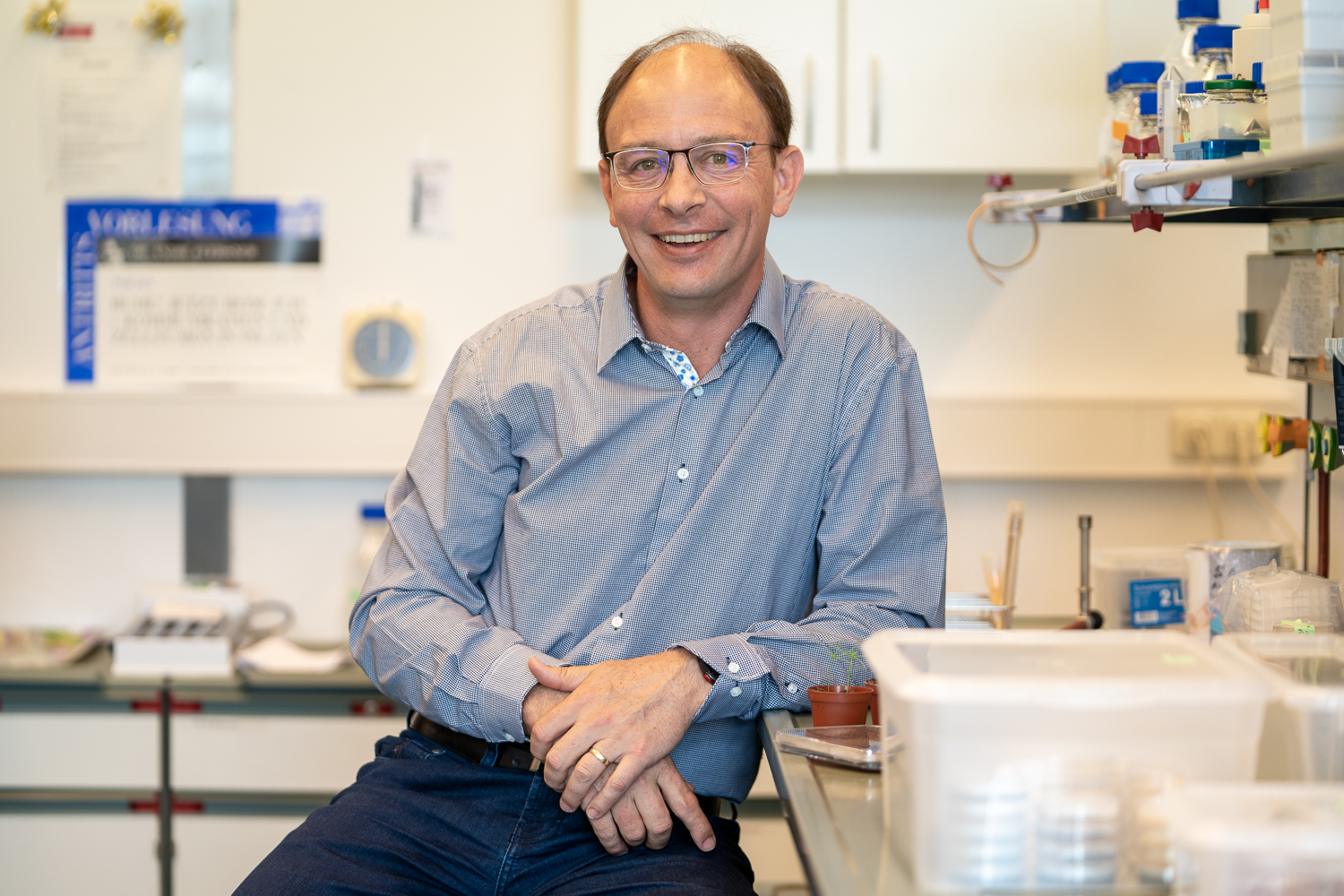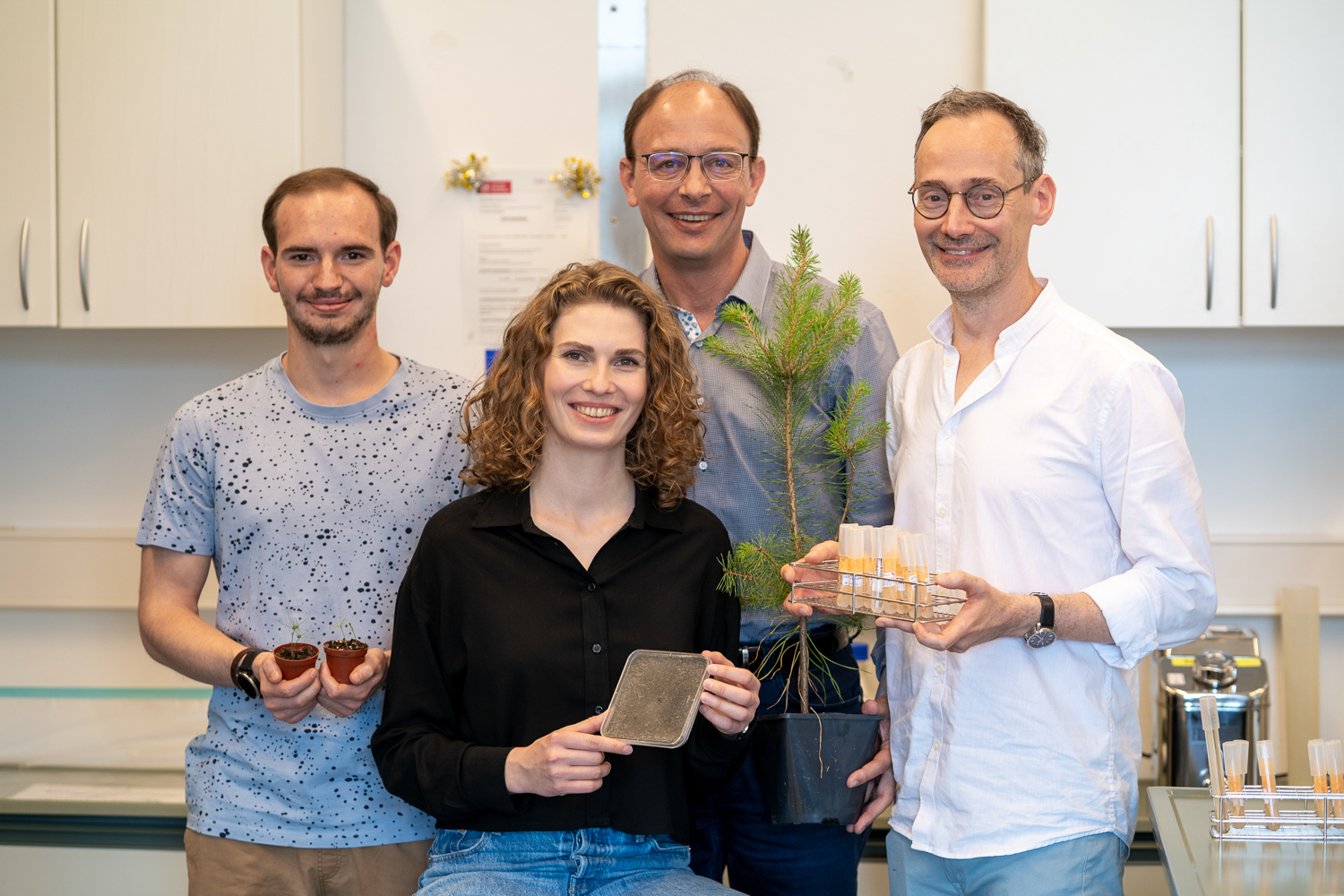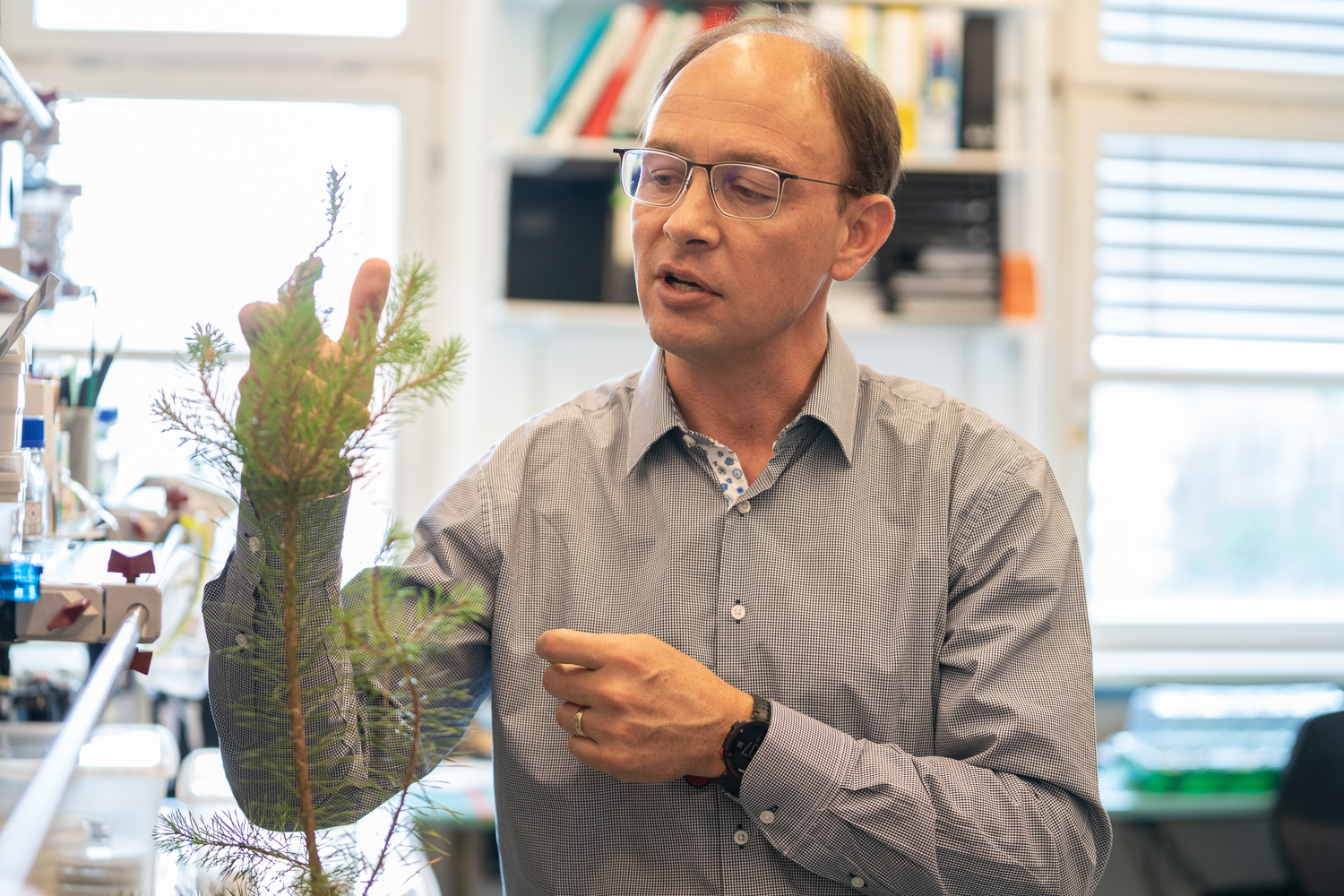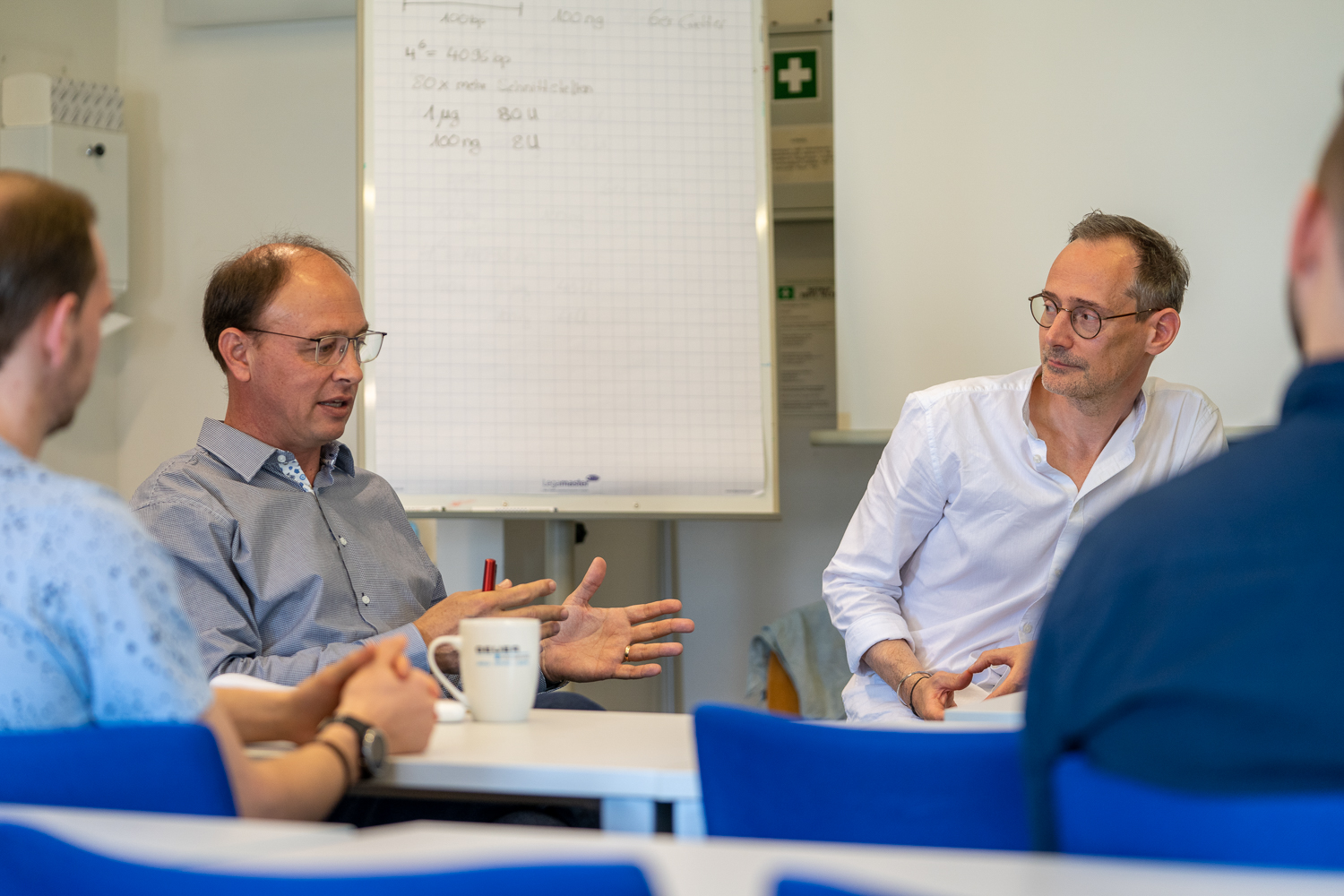The Fungi Connection: “All roads seem to lead to Braunschweig” How a graduate student’s venture into the world of forestry led to a connection that continues to grow
Professor Bernard Slippers is passionate about his research. “If you don’t stop me I will talk about this for hours,” he warns. But there is something captivating in the way he talks about his work with fungi and their effect on trees. He has brought along two tiny pine seedlings less than a month old and one somewhat larger potted sapling to illustrate his points. Here at TU Braunschweig, in the laboratory of Professor André Fleißner’s Fungal Genetics Group, he has found something that was missing from his work at the Forestry and Agricultural Biotechnology Institute (FABI) at the University of Pretoria, South Africa.

Prof. Bernard Slippers, Director of Forestry & Agricultural Biotechnology Institute (FABI), University of Pretoria. Photo credit: Ahmed Nassef/TU Braunschweig
At home in South Africa, Professor Bernard Slippers works extensively with a group of fungi called the Botryosphaeriaceae, which are endophytes of trees that – under certain circumstances, for example changing weather due to climate change – can become pathogens and damage the host tree.
“I’ve worked with this fungus all of my career,“ he says, showing a Petri dish with thousands of tiny black dots. “That is the spore forming structure that makes the propagules that it is going to spread in the environment. When I have worked with this before I would maybe get ten of the structures on a plate because that is what you normally see. And they have developed this method to produce thousands of them consistently.”
Having learned this method from Fleißner’s group in Braunschweig, he can now create large numbers of propagules and spread them on trees to study their development and effects.
The atmosphere in the lab is electric. You can tell that something extraordinary is happening here at the Centre for Biology at TU Braunschweig. It all started with graduate student Anne Oostlander’s decision to present a paper at a forestry conference, which is a somewhat unusual venue in her field. “We usually don’t participate in forestry meetings, that was a really special thing for her to go out of her comfort zone,” explains André Fleißner. “We are very well known in our community. But outside these circles”, he adds, “the picture is somewhat different. There are the people who specialise in field work and there are people like us, who never leave the lab. And they sometimes even have difficulties to understand what the other is saying.” At the conference where Anne presented her work on genetic transformation of her fungus, called Diplodia sapinea, one person fortunately had no problem understanding what he was hearing. Bernard Slippers was intrigued by her findings and immediately saw the potential her work could have for his research. So he contacted the team in Braunschweig to see if he could visit their lab and learn from their work.

Photo credit: Ahmed Nassef/TU Braunschweig
André Fleißner agreed, but with some reservations, “He’s probably going to be disappointed. You know when he is coming here. Not a super big city, small lab, old equipment …” But Bernard Slippers is not at all disappointed:
“The reality is we both work on fungi, but that world is wide, you know. I know all the concepts, I know all the terminology and so forth, but it is applied in a certain mind-set, a certain perspective that is new to me as well. It really blows my world open just to be in the group here.”
The visit already sparked a collaboration that is mushrooming into something much bigger than an exchange between two research groups. “The level of detail that they work on is so specialised they could spend the rest of their lives just talking to other people that do the same thing because there is enough to talk about,” says Slippers.
“So, me coming from a different field of mycology in here, it’s not a conversation I’m used to. It opened my world. And I think some of the same the other way around. I bring a whole different perspective on this fungal world of interactions that is interesting to them as well.”
And it is not only interesting for Fleißner’s group in the Department of Biology at the TU Braunschweig. Their collaboration has already attracted the interest of other institutes, the Helmholtz Centre for Infection Research (HZI) and the Julius Kühn-Institute (JKI) here in Braunschweig.
A world wide web of fungi – leading to Braunschweig

Photo credit: Ahmed Nassef/TU Braunschweig
With researchers from all these different institutions working together, a vision is beginning to unfold that will not only bring the researchers and their work together here at TU Braunschweig, but also from other parts of Germany and even internationally. “We have fungal researchers at the Julius Kühn-Institute, we have fungal researchers at the Helmholtz Centre and here. But we never really did anything together,” says André Fleißner, still a bit puzzled, “it needed Bernard to come here to Braunschweig so that the groups start to collaborate.” Now there are regular exchanges between the groups, they visit each other’s laboratories and share their expertise. It has even prompted Fleißner’s group to venture out of the lab and visit the Julius Kühn-Institute’s research forest outside Braunschweig. Much like Anne Oostlander’s initial urge to see the bigger picture and get a perspective on what their research means in the outside world, there they experienced first-hand what happens when the fungi they study infect the trees.
“It’s not isolated, what’s happening in German forests is connected to the rest of the world. This fungus occurs globally, it has been moved between America, South Africa, Germany, Asia. These things are totally connected. The picture I often have in my mind and that I use when I talk about this, is the way that internet connections have grown —- now everything is connected. And when you think about forest health and about these fungi it literally looks like that,” says Slippers.
“I study this fungus, connections of these fungi from America, from South Africa, from South America, from New Zealand, from all over the world. And if you study how they are connected, they are as connected as we humans are. And they are also connected as a consequence of our connections. We have moved them. We talk about a world wide web of fungi,”
The devastation he has seen here in the forests in the Harz, in South Africa and around the world have had an impact on him: “I have experienced an urge to do more. We have a big global problem; we have to build structures to address this. Figuratively speaking, we need to build international bridges, not just boats going back and forth.” What he had not expected to find here in Braunschweig, was the research capacity and human potential to build these bridges.
“There is enormous potential to build such an pillar here. I was inspired by what I discovered here. I was not aware that there was such a concentration and quality of work. All roads seem to lead to Braunschweig, and all these connections going out from here, I was not expecting that when I came here. If anything, it is really exploding. And that is a very pleasant experience.”
Building bridges
Though researchers may have no trouble understanding each other, there are important conversations to be had with a broader community, says Slippers. To tackle the global issues of forest and plant health in the way they envision, they need not only to bring scientists from different institutions together in more permanent structures. They also need to be part of the societal conversation on the subject. Genetic modification of fungi may help tackle the threats facing forests but the idea of genetic modification still raises fear in some people. “We’re moving into a world – and one has to do that with great care – where the molecular genetic tools that we have in hand now are opening enormous opportunities to do things more sustainably,” says Slippers.

Photo credit: Ahmed Nassef/TU Braunschweig
With the enthusiasm they have already encountered and the wealth of expertise coming together across institutions, what was thought to be a one-off interaction could become a permanent link. Both André Fleißner and Bernard Slippers are optimistic about the future.
“Because there is a lot to explore. For years to come there are careers to develop for young people like Anne, who are at the start of their careers and who helped to kick-start some of this interaction now.”
